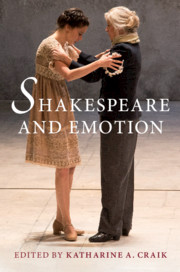Introduction
Published online by Cambridge University Press: 01 October 2020
Summary
Shakespeare was writing his plays and poems just as the word ‘emotion’ was emerging into common currency. In its first usages, traceable back to the 1590s, the term referred to the general disturbance suggested by the Latin term emovere (to move out), and Shakespeare and his contemporaries indeed often described as motions the impulses that aroused the mind, body and soul. The introduction to Shakespeare and Emotion explains the rationale for giving serious and sustained attention to the emotions as a way of approaching Shakespeare’s works as art from the past, as well as the place of these works in the present. It offers a brief survey of Shakespeare’s classical and early modern sources for his understanding of affect, and an account of how the present-day surge of interest in emotional experience builds on earlier strands of Shakespearean scholarship from the early to mid-twentieth century. The Introduction concludes with a survey of the volume’s chapters, organised around the assumption that emotion offers a deeply promising (and often challenging) prospect for imagining and enacting change.
Keywords
- Type
- Chapter
- Information
- Shakespeare and Emotion , pp. 1 - 16Publisher: Cambridge University PressPrint publication year: 2020

